Gas boiler chimney deflector: installation requirements and installation rules
Regardless of the type of fuel, a chimney is a mandatory part of the heating system. It depends on his competent device, it will be so warm in the house.
A special type of fuel is gas, since it is unsafe, so many people are concerned about the question: is a deflector in the chimney of a gas boiler necessary and will such a solution be correct? Let's try to deal with this difficult issue in our material.
The content of the article:
Popular types of traction boosters
In modern design, there are different types of deflectors, so you can choose a model for a house made in any architectural style.
Structurally, these devices differ:
- flat top;
- two ramps;
- semicircular lid;
- folding top.
Each of them has certain advantages: the opening cover on the deflector allows you to control the process of removal of combustion products.
As a decorative element for a roof made in the Art Nouveau style, a flat top is perfect, the best protection against weathering is a gable mini-roof. As a material for their manufacture, galvanized metal is mainly used, but sometimes it is covered with a layer of plastic or enameled.
What is a deflector?
Strong winds can disrupt the stable operation of the gas boiler. In such conditions, automation is often triggered and the boiler shuts down. Combustion products from a gas boiler with their inefficient removal pose a threat not only to health, but also to people's lives.
To increase traction by optimizing air flow, use traction stabilizers or baffles. In translation, its name sounds like a reflector, a deflecting device. In his work, the Bernoulli effect was applied, based on a decrease in pressure during the airflow around an obstacle. It deflects the air masses, increasing the strength of the main chimney stream.

The traction booster works effectively with any wind force, and even during strong gusts, if there is one, the traction will not overturn. But with complete calm, this aerodynamic device acts as an umbrella and is practically inactive, and sometimes reduces traction. For this reason, many experts do not recommend installing baffles on gas flues.
Despite the increased requirements for a deflector mounted on gas boiler chimney, in some cases, this is the only solution to the problem. If this device is not included in the project, it is necessary to coordinate its installation with gas companies. Only after fulfilling this condition, you can proceed with the installation of the deflector.
According to the specifics of the device and associated with this principle of action, the deflectors are divided into the following varieties:
Deflector Design
The deflector prevents direct air flow into the chimney.
As standard, it consists of 3 parts:
- Top cylinder (diffuser) expanded below. It is attached to the bottom using special racks.
- Bottom glass from metal, ceramics or asbestos cement.
- Cap in the form of a cone-shaped umbrella.
The upper part and the lower cylinder are equipped with annular rebounds deflecting air flow. In some models, the top element is missing. Then the lower cylinder is installed on the pipe, then the diffuser and the caps go forward and back.
The device works according to a simple principle:
- the walls of the cylinder located above take a wind blow and direct the air flow around;
- due to the slip on the surface of individual air jets and their rise upward, there is a suction of gases coming from the chimney.
The thrust is amplified in any direction of the wind, except horizontal. In the latter case, air vortices are formed inside the device, cutting off the smoke exit paths. This significant drawback is eliminated by adding an additional element - the inverse cone.

The return cone is installed below the cap. The deflector's task is to ensure that air flows are brought out by crushing them.
Characteristics of popular models
Deflector models differ in both size and wind sensitivity. The most popular models are TsAGI, Khanzhenkov, Volpert-Grigorovich, Smoke Tooth, Hood, aka Sachet, Shenard.The first of these models was developed at the Aerodynamic Institute. Zhukovsky.
More often TsAGI is used in ventilation systems due to difficulties encountered during soot removal. The second model is essentially the same TsAGI, but somewhat improved by the inventor. In fact, this is an additional cylinder around the pipe with an umbrella cover immersed in the cylinder at a certain distance.

The deflector Volpert-Grigorovich has established itself as a traction amplifier in chimneys. It works effectively in areas with prevailing lower winds. The design includes 2 cylinders - the lower one with two outlet pipes and the upper one with a cover.
“Smoke tooth” is mounted in a door specially provided in the chimney. Due to the fact that the design includes 2 handles, you can adjust the air flow.

The Hood deflector has a swivel design. It consists of a semicircular groove-shaped air trap mounted on a rotary rod mounted inside the pipe. The increase in traction power by installing a wind deflector-vane occurs due to the turbulence that occurs when the wind load.
How to calculate a static deflector?
With the independent manufacture of the deflector, it is necessary to perform calculations and sketch a sketch of the future product. It is necessary to proceed from the inner diameter of the chimney.

For a standard device, the parameters can be selected according to the table:
| Pipe inner diameter (cm) | Deflector Height (cm) | Diffuser Diameter (cm) |
| 12 | 14,4 | 24 |
| 14 | 16,8 | 28 |
| 20 | 24 | 40 |
| 40 | 48 | 80 |
| 50 | 60 | 100 |
The table will allow you to choose the dimensions of the deflector without performing calculations. But if there are no suitable sizes in it, you still have to arm yourself with a calculator or find the appropriate program on the Internet.
In the manufacture of the deflector with individual parameters, these special formulas are also used to determine the dimensions:
• D diffuser = 1.2 x dvn. pipes;
• H = 1.6 x dvn. pipes;
• Cover width = 1.7 x dvn. pipes.
Having learned all the sizes, you can calculate the sweep of the umbrella cone. If the diameter and height are known, then the diameter of the round billet can be easily calculated using the Pythagorean theorem:
R = √ (D / 2) ² + H²
Now it is necessary to determine the parameters of the sector, which will subsequently be cut from the workpiece.
The full circle length of 360⁰ L is equal to 2π R. The length of the circle underlying the finished cone Lm will be less than L. The length of the arc of the segment (X) is determined from the difference of these lengths. To do this, make up the proportion:
L / 360⁰ = Lm / X
The desired size is calculated from it: X = 360 x Lm / L. The obtained value of X is subtracted from 360⁰ - this will be the size of the cut sector.
So, if the height of the deflector should be 168 mm and the diameter 280 mm, then the radius of the workpiece is 219 mm, and its circumference is Lm = 218.7 x 2 x 3.14 = 1373 mm. The desired cone will have a circumference of 280 x 3.14 = 879 mm. Hence, 879/1373 x 360⁰ = 230⁰. The cut sector must have an angle of 360 - 230 = 130⁰.
When it is necessary to cut a workpiece in the form of a truncated cone, a more complex problem has to be solved, because the known value will be the height of the truncated part, and not the cone completely. Regardless of this, the calculation is performed based on the same Pythagorean theorem. The full height is found from the proportion:
(D - Dm) / 2H = D / 2Hp
This implies that Hp = D x H / (D-Dm). Having learned this value, calculate the parameters of the workpiece for a full cone and subtract the upper part from it.

Suppose a truncated cone is required, in which H = 240 mm, the diameter at the base is 400 mm, and the upper circle should have a diameter of 300 mm.
- Full height Hp = 400 x 240 / (400 - 300) = 960 mm.
- The external radius of the workpiece is Rz = √ (400/2) ² + 960² = 980.6 mm.
- The radius of the smaller hole is Rm = √ (960 - 240) ² + (300 | 2) ² = 239 mm.
- Sector angle: 360/2 x 400 / 980.6 = 73.4⁰.
It remains to draw one arc with a radius of 980.6 mm and the second with a radius of 239 mm from the same point and draw radii at an angle of 73.4 °. If you plan to overlap the edges, add allowances.
And more about how to build a deflector on a chimney yourself, read Further.
Self assembly device
First, patterns are prepared, then they are laid out on a sheet of metal and parts are cut using special scissors. The body is rolled up, the edges are fastened with rivets. Next, the upper and lower cones are fastened together, using the edge of the first because it is larger and in it you can cut out in several places special mounting cuts with a width of about 1.5 cm, and then bend them.

Before assembly, 3 racks are installed in the lower cone, evenly distributing them around the perimeter and using threaded rods for this. To connect the umbrella to the diffuser, loops of metal strips are riveted on the latter. Racks are screwed into the hinges and for greater reliability, they are fixed with nuts.
Next, they perform installation work on a deflector made by hand in a chimney of a gas or other type of boiler. The assembled device is placed on the pipe and secured using clamps, avoiding gaps. Sometimes the joint is treated with heat-resistant sealant.
Assembling a simple poppet model
The simplest project to implement is the manufacture of a dish-shaped deflector model. Such a cap for the chimney can easily be done with your own hands. Its geometric parameters depend on the diameter of the pipe:
In order not to make a mistake in manufacturing and precisely fit the parts to the required size, it is advisable to first make a model of the deflector from cardboard. At this stage, it is simpler and easier to make adjustments to the design. Cardboard blanks at the same time will serve as original patterns for cutting elements of the future deflector:
Features of mounting a rotary deflector
Turbo deflector rotary deflectorrotary turbine Turbovent - all these names refer to one type of mechanical device for enhancing traction. It consists of a static part connected to the chimney and an active head with blades in the form of a ball.
A rotary deflector is the only device that is not recommended to be mounted on chimneys of stoves heated with solid fuel and wood-burning fireplaces. Turbovent has a characteristic feature - to bleed air from a pipe even during that period when heating does not work.
The direction of rotation of this nozzle does not depend on either the strength or the direction of the wind. It occurs only in one constant direction, creating the effect of an incomplete vacuum. As a result of this, the thrust power increases under conditions of rarefaction of air, and the risk of tipping over the thrust is practically equal to 0.
In the chimneys of gas boilers, Turbovent does its job well and can serve as a decoration for any facade. If you compare it with other types of deflectors, then in terms of efficiency it exceeds them by 2 times.
The base of the rotary deflector can be round, square, flat square. Head sizes range from 100 - 680 mm. Its service life is up to 15 years.
With all the advantages of a rotational turbine, there is one, but a significant drawback - in the absence of wind, the device stops. If at this time precipitation is observed at a temperature below 0, then the head may freeze and it will be necessary to take measures to start it.
Despite the relative complexity of the design, installing a rotary deflector is not difficult. The device has a small weight, so for the installation of enough effort by one person and time of about 2 hours. A suitable place is the highest point of the roof. This arrangement will not allow snow to fall into the pipe if there is an accumulation of precipitation around it.

For different models of rotary turbines, there is one requirement: the temperature of the combustion products above the pipe should not exceed 150-250⁰. The dimensions of the base must be precisely matched to the chimney. The turbocharged deflector must meet the characteristics of the boiler, and this point must be considered when choosing a device.
There are turbo deflectors from different brands on the market. Among the most reputable are Turbovent, Turbomax, Rotowent. The first manufacturer produces products with a base of various geometries.
You can identify them by marking TA-315, TA-355, TA-500. In it, the figure indicates the diameter in the case of a circular cross section or the dimensions of a rectangular base.
Deflector Turbomax produces a Belarusian company. They make devices from high-quality material - stainless steel from a European supplier. Rotowent also made of stainless steel, supplied from Poland. Looks harmoniously on the roof of any type. Suitable for both a chimney and ventilation pipes. Withstands a large working temperature - about 500⁰.
Chimney baffles
Structurally, the chimney weather vane is designed so that the gases, leaving freely on the leeward side, increase the traction force in the chimney. A device made of heat-resistant steel is well established in conditions of high temperatures and the formation of condensate.
Under the curved visor of the fly-gun there is a bearing assembly, which insures against rotation problems. The bearing assembly is bolted to the chimney.The rarefaction zone is created when the air stream passes through the space under the visors.

The minus of chimney weathercocks is that when the wind is strong, they work unstably. The moving part must be periodically cleaned and lubricated. Moisture often accumulates inside the device, and flue gases leave a mark in the form of deposits.
Manufacturers themselves advise using their devices if the chimney is located in an unfavorable place. It, in fact, does not increase traction, but only protects the chimney.
Conclusions and useful video on the topic
Is it worth it to install a traction amplifier in the presence of a gas boiler, you will find out by watching this video:
It’s not easy to make a turbo deflector with your own hands, but some craftsmen still do this and successfully operate it. Watch this in the video:
There are a lot of designs of deflectors, but we must not forget that gas is used for heating. Not all models can be used. Some of them are not suitable in principle because intended for ventilation. In order not to block the smoke removal system, you must always consult a specialist and obtain permission to install a baffle.
Looking for a chimney deflector? Or is there experience in manufacturing or installing this device? Please share it with visitors to our site. Also, in the block with comments, you can ask interesting questions on the topic of the article.

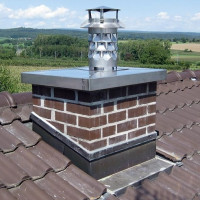 How to put a deflector on a chimney with your own hands: step-by-step instruction
How to put a deflector on a chimney with your own hands: step-by-step instruction 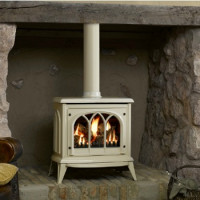 How to make a chimney for a fireplace: the rules of the device of the smoke channel and a comparison of designs
How to make a chimney for a fireplace: the rules of the device of the smoke channel and a comparison of designs  How is a ceramic chimney constructed: the specifics of installing a ceramic chimney
How is a ceramic chimney constructed: the specifics of installing a ceramic chimney 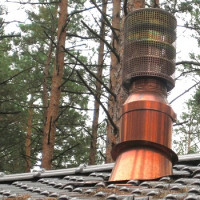 How to make a spark arrestor on a chimney with your own hands: a step-by-step guide
How to make a spark arrestor on a chimney with your own hands: a step-by-step guide 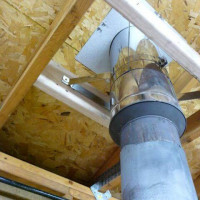 How to make the right chimney for a do-it-yourself stove: a step-by-step instruction
How to make the right chimney for a do-it-yourself stove: a step-by-step instruction 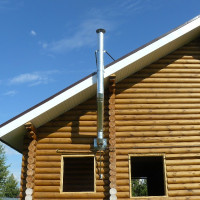 How to make a chimney in a private house with your own hands: design options and their implementation
How to make a chimney in a private house with your own hands: design options and their implementation  How much does it cost to connect gas to a private house: the price of organizing gas supply
How much does it cost to connect gas to a private house: the price of organizing gas supply  The best washing machines with dryer: model rating and customer tips
The best washing machines with dryer: model rating and customer tips  What is the color temperature of light and the nuances of choosing the temperature of the lamps to suit your needs
What is the color temperature of light and the nuances of choosing the temperature of the lamps to suit your needs  Replacement of a geyser in an apartment: replacement paperwork + basic norms and requirements
Replacement of a geyser in an apartment: replacement paperwork + basic norms and requirements
We passed this science gradually. Having no special knowledge in this area, we purchased a gas boiler. The masters who installed it told us about the need for a deflector, but out of ignorance I did not attach importance to the words. Then the whistle with outages began, it’s good that the automatics worked. After he began to pay attention to the construction of pipes of houses.
Well, and what kind of deflector installed?
Hello. I have a gas boiler, a fume hood is straight. I wanted to know which deflector to install.